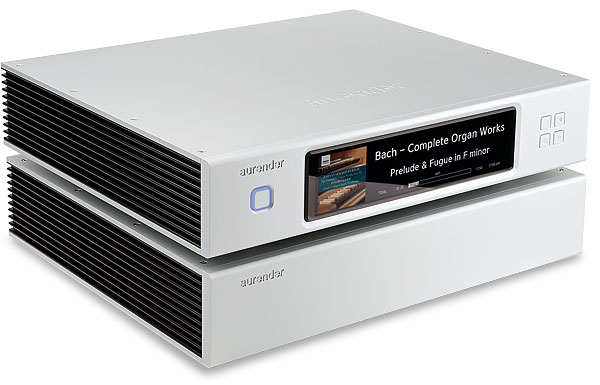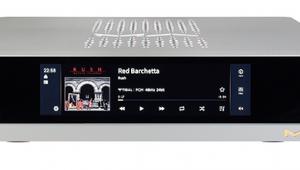Aurender N30SA Network Audio Library Page 2
![]() Andrew Auditions
Andrew Auditions
As mentioned before with devices of this kind, the N30SA doesn't have a 'sound' of its own. Instead, it gives the connected DAC the best possible opportunity to shine by presenting it with a super-clean digital feed, and with as much interference as possible eliminated. That's immediately apparent when using a top-notch DAC such as the dCS Vivaldi One APEX in PM's reference system – but also with less ambitious digital converters, from the iFi Audio NEO Stream [HFN Mar '23] or Chord Mojo 2 [HFN Apr '22] down to the likes of the little AudioQuest DragonFly 'DAC in a stick'.
Returning to the dCS Vivaldi One APEX, the impact of Aurender's N30SA was evident when playing the Ensemble Allegria recording of Britten's Variations On A Theme Of Frank Bridge [Lawo LWC1241], with a remarkable sense of space and instrumental definition, and real impetus and drive in the Variation 2 'March'. The same was true with cellist Camille Thomas's The Chopin Project: Complete Chamber Music release [DG 4858596], with remarkable, intricate detail revealed in the Grand Duo for cello and piano. Everything here sounded just that bit more real, without any suspicion of things being over-processed or forced.

Those same qualities were clear even with the full-on mixes on Whitesnake's Still…Good To Be Bad remaster [Rhino 603497836918], the chugging drive of 'A Fool In Love' still not the cleanest of sounds despite the reworking, but having real power, fine instrumental clarity and a satisfying snarl.
Good Times
Strip things back to The Knack's 'My Sharona', from Live At The House Of Blues [Liberation Hall/Smile LIB-5077], and all that weight and drive is there, along with excellent ambience. Similarly, on the cover of The Monkees' 'Last Train To Clarksville' the detail really gets the listener into the good-time atmosphere.
Change pace to the lush sound and close harmonies of The King's Singers' When You Wish Upon A Star album of music from Disney films [Warner Classics 5419736740], and that ability of the Aurender/dCS combination to dig deep and let you hear what each voice is doing greatly enhances the appreciation of the musical skill playing out before you. This was especially true of tracks including 'The Second Star From The Right', while also ensuring Joyce DiDonato's voice soared out of the arrangement of 'Colours Of The Wind'.
In The Moog
With Taj Mahal's Savoy album [Stony Plain Records SPCD1470], the N30SA lends its clarity not just to the appropriately chilly version of 'Baby It's Cold Outside', with lovely guest vocals by Maria Muldaur, but also to the standout covers of many jazz and blue standards, culminating in a big, rich 'One For My Baby…', ending the album with a real late-night feel.
That ability to delve deep into a mix without the artificial impression of disassembling the music was especially clear when playing Thierry Maillard's The Moog Project album [Ilona Records LIR 9302396]. This draws heavily on the Supertramp back catalogue, treating familiar songs to funked-up jazz arrangements understandably heavy on electronic instruments, from the synths of the title to syndrums and analogue electric pianos. The album benefits from the absolute clarity of the bass and percussion, both in the recording and the way the N30SA enables a DAC to handle it.

What's more, the keyboards are set front and centre, and have the same kind of period character one might identify in an 'authentic instruments' classical recording, or one of an historic fortepiano. As with the other recordings sampled, the N30SA's contribution was clear whatever DAC was hosted, but the subtlety of the sound, its black silences and micro-dynamics were even more transparent with the highest quality converters.
Then, just when you think you're getting all the system has to give, switch the N30SA into 'critical listening mode' – and it summons just a little more information to delight, whether that's the bite of a bow on the strings of a cello, or the tell-tale switching of (relatively) ancient electronic keyboards.
And this set-up loves voices, as is obvious with the Rias Kammerchor/Akademie Für Alte Musik Berlin/Justin Doyle recording of Handel's Coronation Anthems [Harmonia Mundi HMM902708]. Released just before King Charles III's crowning, it's a set of thrilling instrumental and vocal performances, especially if you swerve the obvious 'Zadok The Priest' and delve deeper into the other three anthems, where the precision and richness of 'The King Shall Rejoice' is especially rewarding.
It all goes to show that while the quality of the DAC and analogue components in a system are of paramount importance, what happens before the music is converted from digital data has a major role to play.
Hi-Fi News Verdict
For all the protestations of the 'bits is bits' absolutists, the proof that 'digital done right' has a crucial role to play is in the listening, as demonstrated by Aurender's N30SA. Provided the rest of your playback chain is optimised, its cossetting of data coming from network or onboard storage can enhance both musical communication and involvement. Yes, it's a luxury, but it's one that's well worth having.


















































